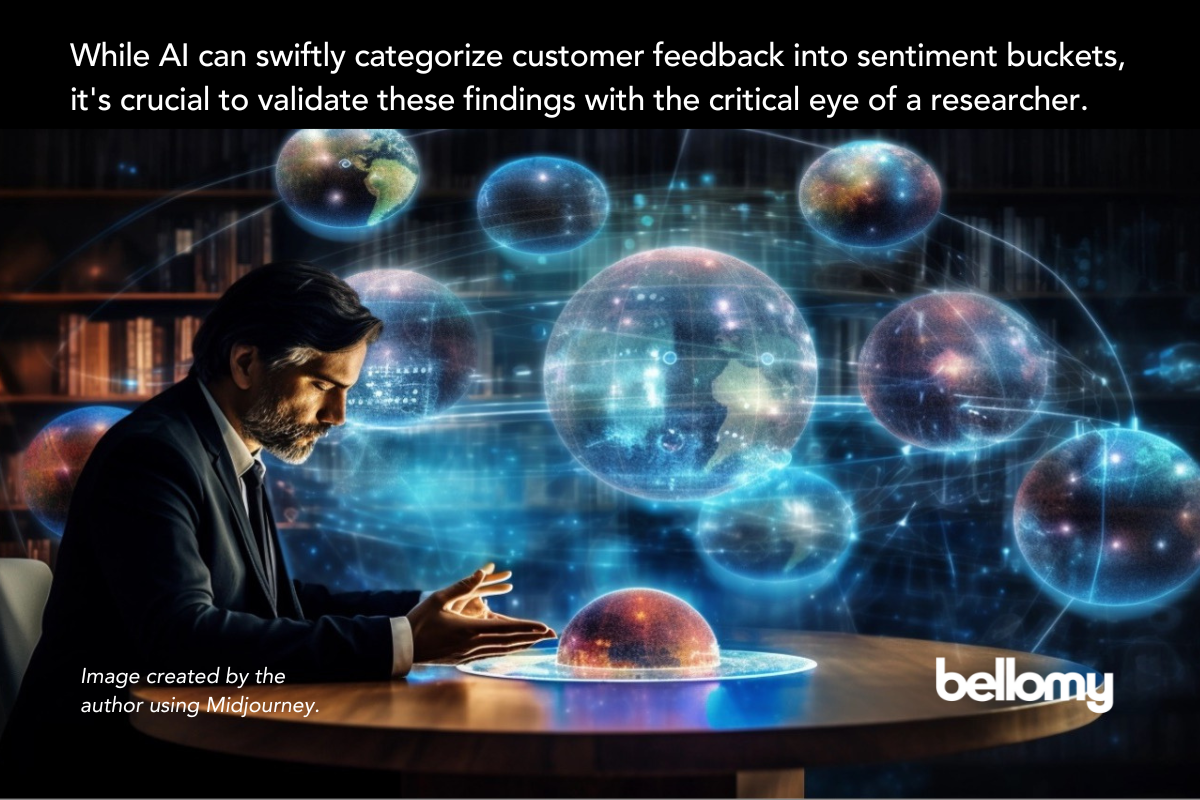Navigating AI's true impact on market research
With all the talk about AI and transforming the insights industry, it's crucial to strip away the hyperbole and focus on high-quality insight outcomes, not just the technology behind it. As steadfast navigators in the ever-evolving landscape of market research, we must dissect the real from the razzle-dazzle to understand AI's true capabilities and limitations.
AI has been heralded as the miracle child of modern technology, especially within the market research industry. Indeed, generative AI, such as ChatGPT, has carved its niche as an invaluable asset. Its capacity to churn out analyses with the apparent fluency of a seasoned analyst is nothing short of breathtaking. However, relying solely on its glossy veneer is akin to playing Chopin on a piano without hammers. Sure, the potential is there, but without the full suite of tools, the final melody falls flat. AI does not simply replace the core competencies of market research; it requires a blend of innovative technology and time-honored techniques to achieve optimal results and maintain the quality and trustworthiness that the work demands.

Validation and contextualization of AI analytics
Diving deeper, one must not be beguiled by the effortless ease with which AI performs data analyses. While AI can swiftly categorize customer feedback into sentiment buckets, it's crucial to validate these findings with the critical eye of a researcher.
Consider the Bellomy Research Cloud's dashboarding capabilities, lifeblood tools of the modern researcher. AI may swiftly categorize customer feedback into sentiment buckets, but does it capture the nuances? Dashboarding tools allow researchers to see broad trends and zoom in on anomalies and outliers that AI may overlook. Using dashboards effectively is crucial for providing insights that, when widely shared and understood within an organization, are essential for driving organizational change.
Text analytics, another cornerstone of the toolkit, goes beyond mere word frequency analysis. It employs algorithms that identify themes and patterns but requires a seasoned eye to discern the subtleties of language — sarcasm, double entendres, and cultural references that often fly under AI's radar. Without this human-augmented verification, insights risk being superficial and potentially misleading.
AI may offer a hypothesis about a purchasing trend based on demographic data, but what happens when we apply cross-tabulation? Suddenly the relationships between variables are in stark relief, with human analysts using the tool to probe deeper, ask why, and challenge AI-generated assumptions.
Case management tools further marry the value of AI with human scrutiny. Even if AI identifies potential leads or flags customer issues for follow-up, it's the researcher's experience and intuition that determine the gravity and appropriate response to these flags. These tools are not mere appendages but critical extensions of the researcher's faculties, allowing them to stitch a richer tapestry of the customer experience.
Moreover, contextualization is essential to weave AI-generated insights into the fabric of knowledge that seasoned researchers can provide. Data without context is like an unfinished story — compelling but ultimately unsatisfying.
Effective distribution of findings
One must not overlook the artistry involved in conveying the wealth of knowledge unearthed by insight professionals. It is not just about accumulating data; it is about storytelling, transforming the cold, hard numbers into narratives that resonate on a human level. AI can help with this, but AI alone is not a means to deliver the story and communicate insights to the client.
The Research Cloud encompasses not just dashboarding and crosstabulation but extends to the realm of text analytics with a human touch and media galleries. It ensures that the distribution of findings is not just an afterthought but a carefully crafted part of the research process extending research to business operationalization.
AI use cases and quality standards
In the face of this technological renaissance, we encounter a stark reality—AI's wisdom is often siloed, confined to the minds of a few adept practitioners. Yet this fosters a risky dependency, akin to a single bolt supporting a grand bridge.
To maximize the benefits of AI, it is imperative to systematize AI use cases and establish reliable, reusable practices within the organizational DNA. When quality standards become the norm and business processes are redesigned to accommodate AI, the knowledge monopoly crumbles, giving rise to maximum benefits.
Establishing reliability in AI
Similar to a new medical treatment undergoing rigorous trials, AI must endure exhaustive validation to be deemed trustworthy. Reliability is the cornerstone upon which market research rests. Bellomy's Insights Technology team is constantly refining the Research Cloud to meet these exacting standards. The toolset not only empowers researchers with data access and survey administration but also ensures that business workflows and best practices are systematized to maximize quality and consistency across users and use cases.
Fusing AI with traditional market research
AI is not a disruptive tornado uprooting the foundations of market research. Instead, it is a wind that, when harnessed, can propel us to greater heights of understanding and insight. Our task, as custodians of consumer insights, is to employ AI as a partner—an ally to bolster, not supplant, the irreplaceable human elements of our craft. By merging the prescient power of AI with the irrevocable value of validation, context, and effective communication, we don't just ride the wave of progress; we direct its course.
In the Research Cloud, we find not a fleeting trend but a steadfast companion for the journey ahead—a testament to the need to bring man and machine together, advancing the state of market research with every byte and every insight. Remember, in the grand tapestry of market research, AI is but a single, albeit gleaming, thread. It is our hand that guides the loom, our vision that sees the pattern emerging, and our dedication to the craft that transforms a glimmer of potential into the gold standard.
Matt Gullett, Bellomy’s SVP of Insights Technology, is a driving force behind Bellomy AI Analytics. An employee of more than 20 years, he loves thinking and writing about AI.
Images created by the author using MidJourney.

